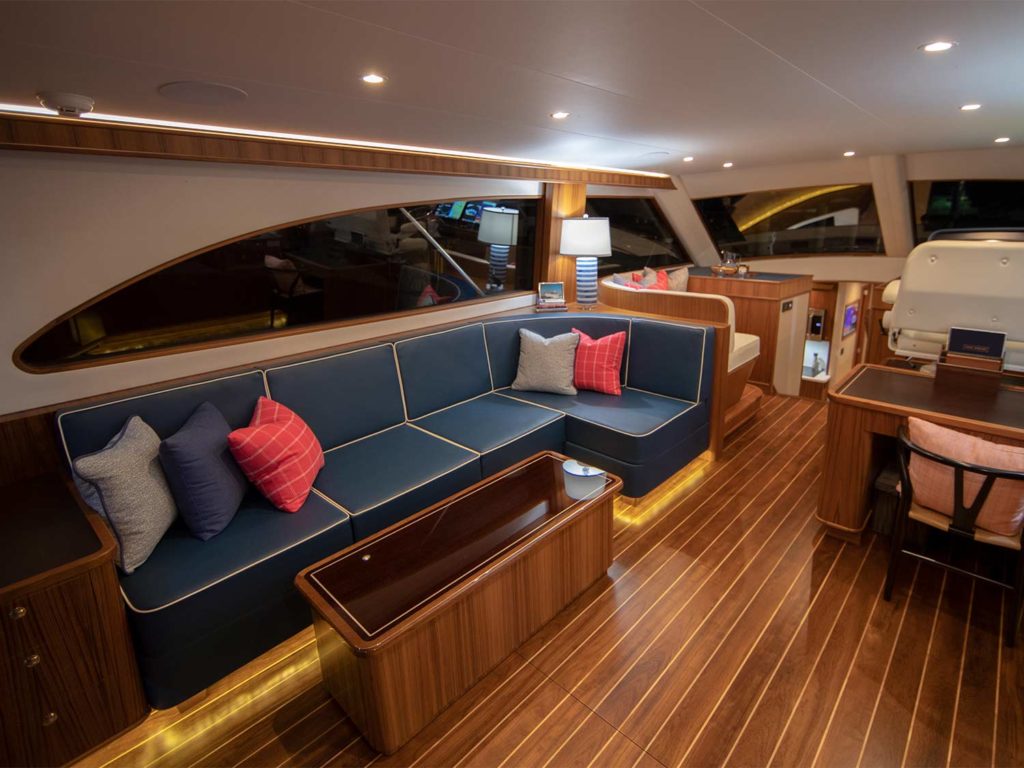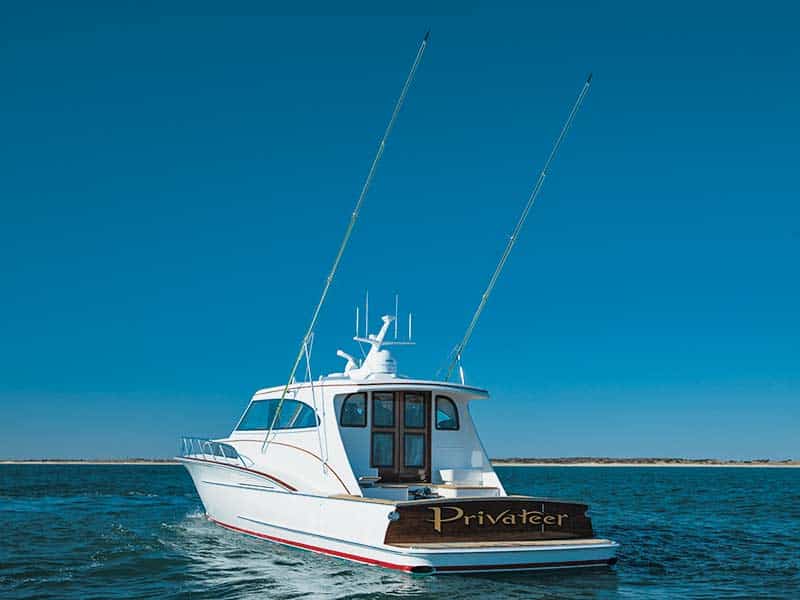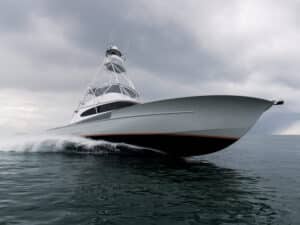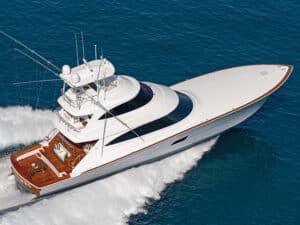
With more than 100 boats delivered since 1986, it’s no wonder Beaufort, North Carolina’s Jarrett Bay Boatworks founder Randy Ramsey lives by the belief, “If you want it, we can build it—and service it—anywhere, anytime,” when it comes to his company’s truly custom products. And with a family of customers spanning the globe, one in particular knew exactly what he wanted, and where he could get it. Armed with a picture of an old trunk-cabin Rybovich, the owner of Privateer, a 67-foot Jarrett Bay, embarked on a journey that began with a simple meeting and ended with the boat of his dreams.
The throwback trunk-cabin design is rarely utilized by a Carolina boatbuilder, but when it is, it not only becomes personal but also very memorable.
At the Palm Beach Boat Show, I was privy to a showing that was as comprehensive as it could get. Privateer‘s Project Manager, Nile Mitchell, had an answer for every question and a reason for every detail. Not only is Privateer one of a kind, she is also different from anything else out there. Not one to follow a crowd, this Jarrett Bay goes further than the crowd.

Hull and Superstructure
Each Jarrett Bay is a custom construction project built in cold-molded fashion. The bottom consists of three layers of fir plywood for both durability and impact resistance, while Okoume’s properties provide the perfect canvas for the sexy curves and blemish-free hull.
Designed and built specifically for Privateer‘s rather tall owner, headroom not typically found in modern sport-fishers was in order. The salon of any ordinary sportboat can accommodate just about all persons of height, but once down the companionway, it can become a real issue.
One of the most interesting features of the superstructure was the hardtop. Because the Privateer family likes to have a variety of options—fish, cruise or just chill out at anchor in the Bahamas—this hardtop, which is accessed by way of three molded steps that are recessed in the center window frame, was adapted to store kayaks and paddleboards on custom powder-coated cradles for days when exploration is on the agenda.
For the design team, the elevation of one element created a trickle effect: if one came up, it all had to come up. The result: Angles that line up perfectly, flowing in a way that is pleasing to the eye, and the hull is still very much a Jarrett Bay.
Performance
On the boat show move-out day, I hopped onboard for a sea trial. As the tide pushed hard into the seawall, the 67 was spot-on responsive and pivoted perfectly on her axis.
Her twin Caterpillar C18 ACERTs propel Privateer with impressive performance numbers. At a cruising speed of just over 26 knots pushing 2,000 rpm, she burns a modest 90 gallons per hour, and the best description I can come up with for this ride is smooth and silky.
In Privateer you get the best of all worlds: the feel of a motoryacht, the solid platform of a large trawler, and the hull performance of a Carolina-made sport-fisher.

Interior and Helm Station
The raised overhead of 6 feet, 9 inches, and what seems like limitless windows in the interior—upstairs and down—gives the impression of a space where a family can really live with plenty of breathing room, while satin teak veneers fill the three-stateroom/two-head space with luxury.
As you enter the salon through two massive centerline sliding doors, you find a roomy, naturally-lit space done in a traditional nautical look. Wide-plank teak and maple floors complement the portside navy blue lounge. To starboard, a long teak cabinet runs the length of the salon—housing bar essentials, an ice machine, and a small stainless-steel sink—ending at a captain’s chart table just aft of the helm station.
A large, double Stidd helm seat is mounted atop another teak cabinet opposite a cream-colored U-shaped navigator’s lounge, and the visibility offered at this owner-operated helm does not disappoint.

Down the stairs, the galley opens up with more than 7 feet of clearance and the wide-plank maple sole brightens it even more. A full standup refrigerator occupies the aft bulkhead and an L-shaped galley runs along the port side, offering plenty of prep and cooking area. Every extra bit of galley space that was not already part of existing storage was fashioned into one; like the sweet breakfast nook laying to starboard.
An inviting portside guest room, a large, casually refined full-beam master with en suite head sits midlevel, and the VIP is all the way down and aft, where a washer and dryer hide behind clever cabinetry. Both heads are huge and flooded with natural light, thanks to the generous trunk windows.

Cockpit and Engine Room
The 136-square-foot cockpit is superclean, rendering a stage for all kinds of water activities. The built-in swim platform provides easy access in and out of the transom gate to either launch the water toys or go for a swim.
A huge, double-lidded transom box means there is also plenty of fishing to be had aboard Privateer. The cockpit is styled like a sportfisherman, complete with teak deck, covering boards and rocket launcher.
A centerline-split mezzanine creates ample tackle storage, refrigeration and a deep ice bin; classic white cushions piped in navy adorn two lounges that flank the solid teak salon doors, and the LED under-gunwale lighting keeps the cockpit lit well enough for passengers to move around safely at night.
With the many components and systems living in the engine room, the owner insisted they all be accessible.
Read our review of the Jarrett Bay 46 here.
Instead of the boat being built around them, Jarrett Bay obliged with 6 feet, 6 inches of headroom, and every major system can be reached for repairs and replacement if and when the time comes. It’s refreshing to see a builder who steps outside the box like this.
The vessel’s powerplant generates close to 2,300 horsepower and the list of modern systems is virtually endless: dual Caterpillar C2.2T generators; Seakeeper 16 gyrostabilizer; livewell system; Caterpillar/Twin Disc/BCS hydraulic bow thruster; and 24-volt electric cockpit outlets.
One particularly inventive feature is a salon subfloor with two removeable access panels that allow small systems, such as pumps and air conditioners to be passed through easily, and if needed, the larger panel can be removed to accommodate bigger items, such as generators and engine components. To say not a stone was unturned when laying out this Jarrett Bay is an understatement.
Nostalgia and performance are the key elements in this exclusively designed 67-footer. From a distance, Privateer‘s magnetism draws you in; you find yourself trying to peek through the windows, wondering what exactly lies inside this sleek and modern American beauty. Now you know.
Specs
| LOA: | 67’3″ |
| Beam: | 18’2″ |
| Draft: | 4’9″ |
| Displ: | 64,000 lb. |
| Fuel: | 1,320 gal. |
| Water: | 200 gal. |
| Power: | Twin 1,136 HP Caterpillar C18 ACERT |
| Gears/Ratio: | Twin Disc/2:01 |
| Propellers: | Veem—32 dia. 41 pitch |
| Climate Control: | Dometic |
| Paint: | Topsides—Alexseal; Antifouling—Petit |









